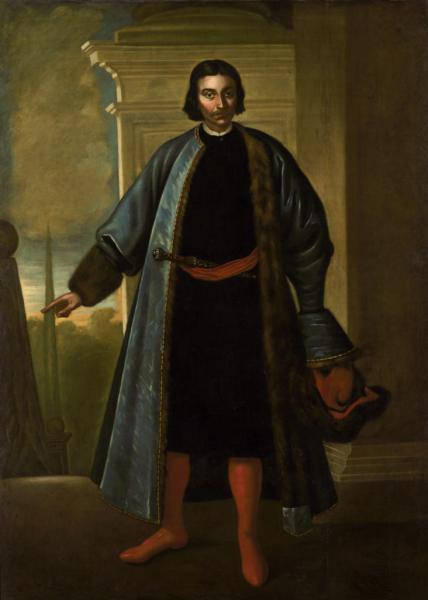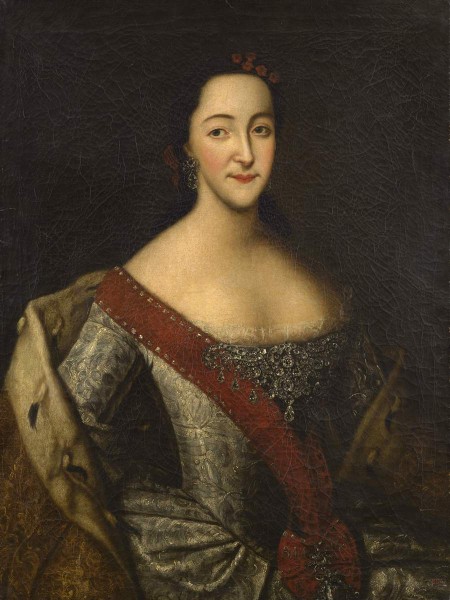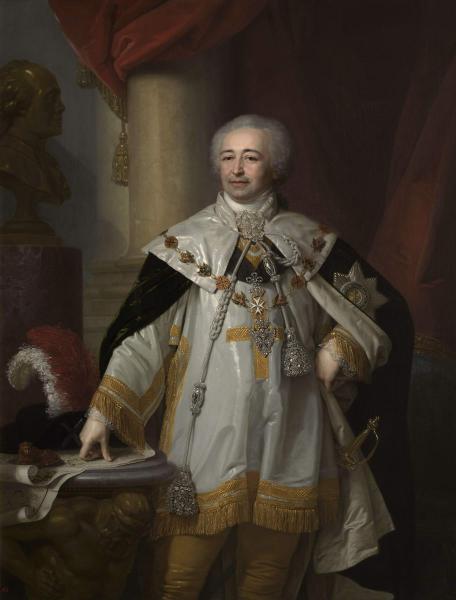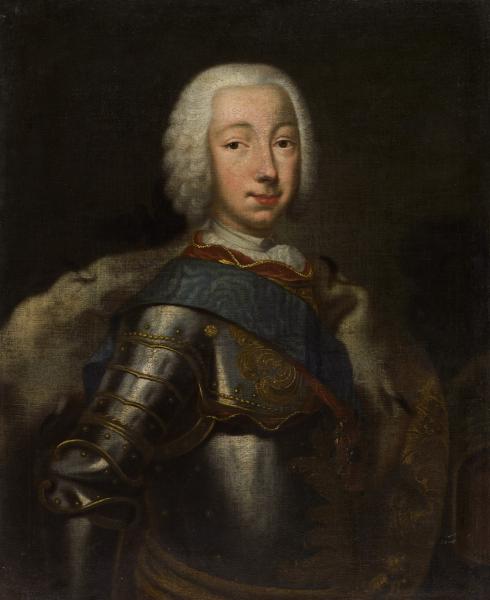The artist is unknown

+ Virtual excursion &Laquyagilev. START&Raquo >>>
– Hide the text of a virtual tour &Laquyagilev. START&Raquo
In the second half of the XVII century, the boyar-queen portrait is very widespread. The impressiveness of images, the brightness and decorativeness of painting perfectly corresponded to the splendor of the court life. Such "Persons" representatives of the princely kind of repnins. The famous cycle consisting of three paintings "In growth", Presented at the exhibition “Portrait of Andrei Menshoy Ivanovich Repnin”, made by an unknown master of the Moscow arms chamber of the second half of the 17th century.
Andrey Menshoy Ivanovich Repnin, youngest son of Ivan Borisovich Repnin – Stolnik, and then the near boyar and the butler king Alexei Mikhailovich. A portrait of Andrei Menshoy, like others in this series, is characterized by a monumental composition and colorful color combinations. Here techniques are used typical for the future ceremonial portrait. Impressive pose, background with heavy drapery and architectural details, luxurious costume and accessories – emphasize the high social status of the model. The character is dressed in full accordance with the decree of Tsar Fedor Alekseevich 1681, according to which the nobles, nobles and ordered people were to be worn "Short caftans and Ferezi in Polish fashion". On the depicted – "Polish fur coat" Without a collar, black zipun, in the hands – a Polish hat -shaped hat with a red top and a fur coat, red boots on his feet.
E.AT.Amphilokhiev, e.AT.Stankevich and N.AND.Fedorova. Materials for a virtual tour of the exhibition "Diaghilev. Start". 2009
Go to the beginning of the virtual tour “Diaghilev. START”
Andrey Menshoy Ivanovich Repnin (?–1699) – the youngest son of the neighboring boyar and the butler king Alexei Mikhailovich and. B. Repnin (1615–1697) and E. N. Pleshcheeva (?–1695).
Peter I. Time and environment. SPb, 2015. With. 125.
The traditional definition of depicted as Prince Alexander Borisovich Repnin (Petrov 1870. With. eight. No. 24), adopted by the researchers of the second half of the XIX – early XXI centuries, has recently been revised (n. X. 2012. With. 21. No. 6; Moiseeva 2014. With. 46–63). The new version was adopted by the attribution council of the Russian Museum in 2014. Pomprat dates from the costume 1680–1690 (Leto 2006. With. 59). The customer of the images, apparently, became the survivor of both brothers Prince Anikit Ivanovich. Svetlana Moiseeva // Peter I. Time and environment. SPb, 2015. With. 93.
As a result of a pre -exemption study, it is defined as a portrait of Prince Andrei the Menic (Junior) Repnin – the youngest son and. B. Repnin and e. N. Pleshcheeva, named in memory of the early deceased brother. He was married to Tatyan NN, who died on December 25, 1715 “(Russian genealogy book. With. 271). This portrait is of particular interest. According to the researchers, he “demonstrates a new stage in the development of the Russian costume, which began in October 1681, when Tsar Fedor Alekseevich indicated to the nobles, nobles and ordered people to wear short caftans and Ferezi in Polish fashion instead of old -storey ohabnies and single -rhizas, in which not only prohibited not only forbidden come to the court, but even enter the Kremlin territory “.
The character in the portrait is dressed in full accordance with Decree 1681. Long -legged robe on fur – the so -called Polish fur coat. Under the fur coat, black zipun, fastened obliquely on the left side in accordance with the fashion borrowed from Turkey. This cut of the lower dress was very characteristic of the Russian costume of 1681-1700. For this time, the headdress shown in the prince’s right hand is also typical of the prince “Polish Cap-Rapid with a red top and curly fur coat” (Letin. With. 59).
Portraits of Andrei Bolshoi and Andrei the Menshoy unite that the characters are smoothly shaved, while Annikita Ivanovich is depicted with a black salary beard. Under Tsar Alexei Mikhailovich Braudbot, it was as prohibited as wearing a European dress. Judging by some sources, the first wife of Tsar Fedor Alekseevich, Pole Agafya Grushetskaya, persuaded him not only to cancel the Okhabni, but also to cut her hair and shave his beards. Officially shaving the beard was not allowed, but the authorities did not persecute the “brawbris”. Thus, the beards became obligatory to shave only since August 1698, after the return of Peter I from a trip to Europe.
Apparently, the time of the execution of portraits of Andrei Bolshoi and Andrei Menshoy should be considered the last years of the XVII century. The year of the birth of Andrei Menshoy is unknown, but in any case he was younger than Annikita, therefore, at the end of the 17th century he was about thirty years old. N. X. Unknown artist. SPb, 2012. With. 20-21.
Show the full text
Hide the full text
Portraits of the Princes of the Repnins who received the Russian Museum from IAX are extremely important and characteristic works of Parsuns, classical examples of this type of image.
According to n. M. Moleva, they come from the family meeting of the repnins, their last owner was the prince p. And. Repnin (about 1718–1778). About 1755 Prince Petr Ivanovich sold his large house with an extensive land plot of Moscow University, and portraits of repnins, together with the house, passed into possession and. And. Shuvalova, who handed them to the IAX (Molieva 1994. With. 51–52). However, for the first time “belonging to the Imperial Academy of Arts” they were mentioned in the catalog of the arranged. N. Petrov Historical Exhibition of 1870 (Kat. historical exhibition. With. 3. No. 2; With. 4. Number 3; With. 16. No. 45).
All three portraits were exhibited at the Tauride exhibition (1905), but the catalog was mentioned as images of Prince Ivan Borisovich, Prince Athanasius Borisovich and Prince Peter Alexandrovich (Kat. Tauride exhibition . With. one. No. 1408, 1409, 1410). In the Russian Museum, upon receipt, portraits were recorded in an inventory book under the names of Ivan Borisovich, Alexander Borisovich and Afanasy Borisovich Repnins. So they were mentioned in the catalogs of the meeting and exhibitions.
Their characters allegedly belonged to the XXIII knee of the genealogical tree of the princes of repnies. Their traditional dating of the 1690s did not cause any objections, especially since they all filed in the scheme of the “Sarmatian” portrait, widespread in the Russian art of the line of the XVII-XVIII centuries.
For the first time with. AND. Letin rightly doubted that the inscription on one of the images of “Partret of Prince Alexander Borisievich Repnin” corresponds to the name of the depicted (Letin. With. 61, 62). “Russian genealogy book” p. AT. Dolgorukova clearly testifies that Prince Alexander Borisovich was absent in the “Knee XXIII”. He was formed by two sons of Prince Boris Alexandrovich – Prince Ivan Borisovich, boyar, who died on June 5, 1697, and Prince Afanasy Borisovich, who died on November 25, 1653.
The presence of three repnins brothers “Russian genealogy book” indicates only in the “Knee XXIV”. These were the sons of Prince Ivan Borisovich: Prince Andrei Bolshoi Ivanovich, Prince Annikit Ivanovich and Prince Andrei Menshoy Ivanovich (Russian genealogy book. With. 271). They are, in our opinion, models of portraits. At the end of the XVII century, the brothers were about thirty years old, which corresponds to the age of the repnins depicted on the Parsunes. N. X. Unknown artist. SPb, 2012. With. eighteen.


